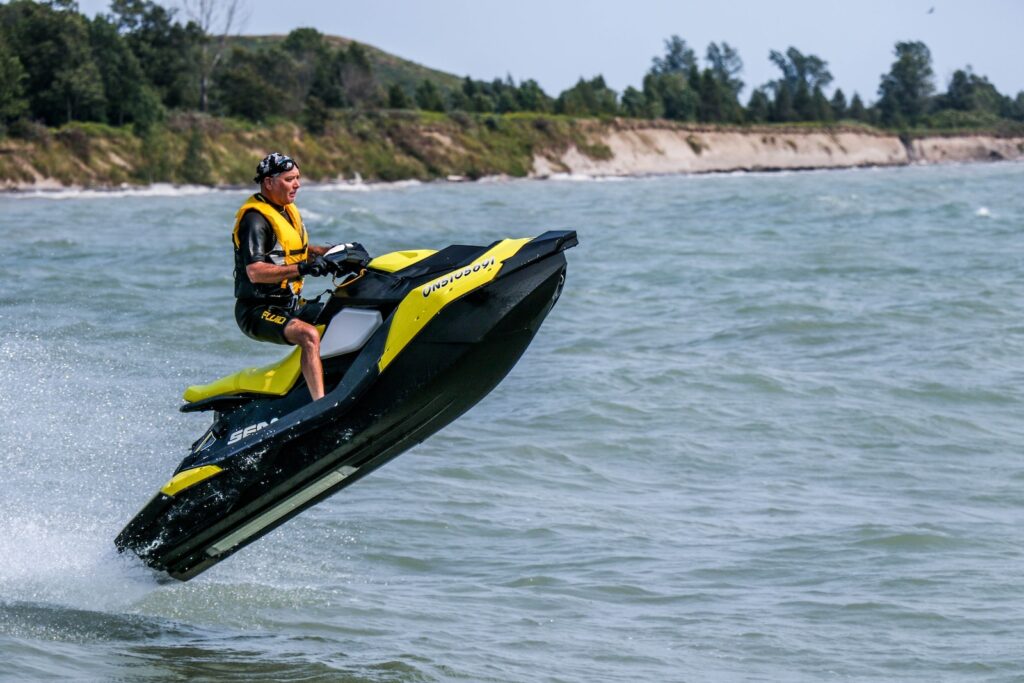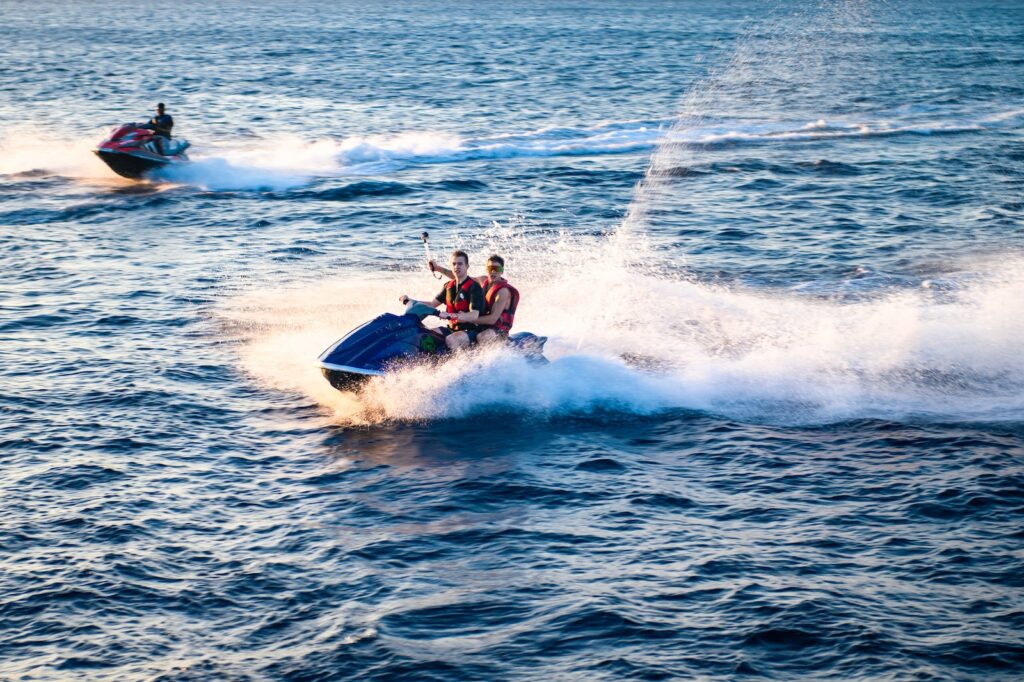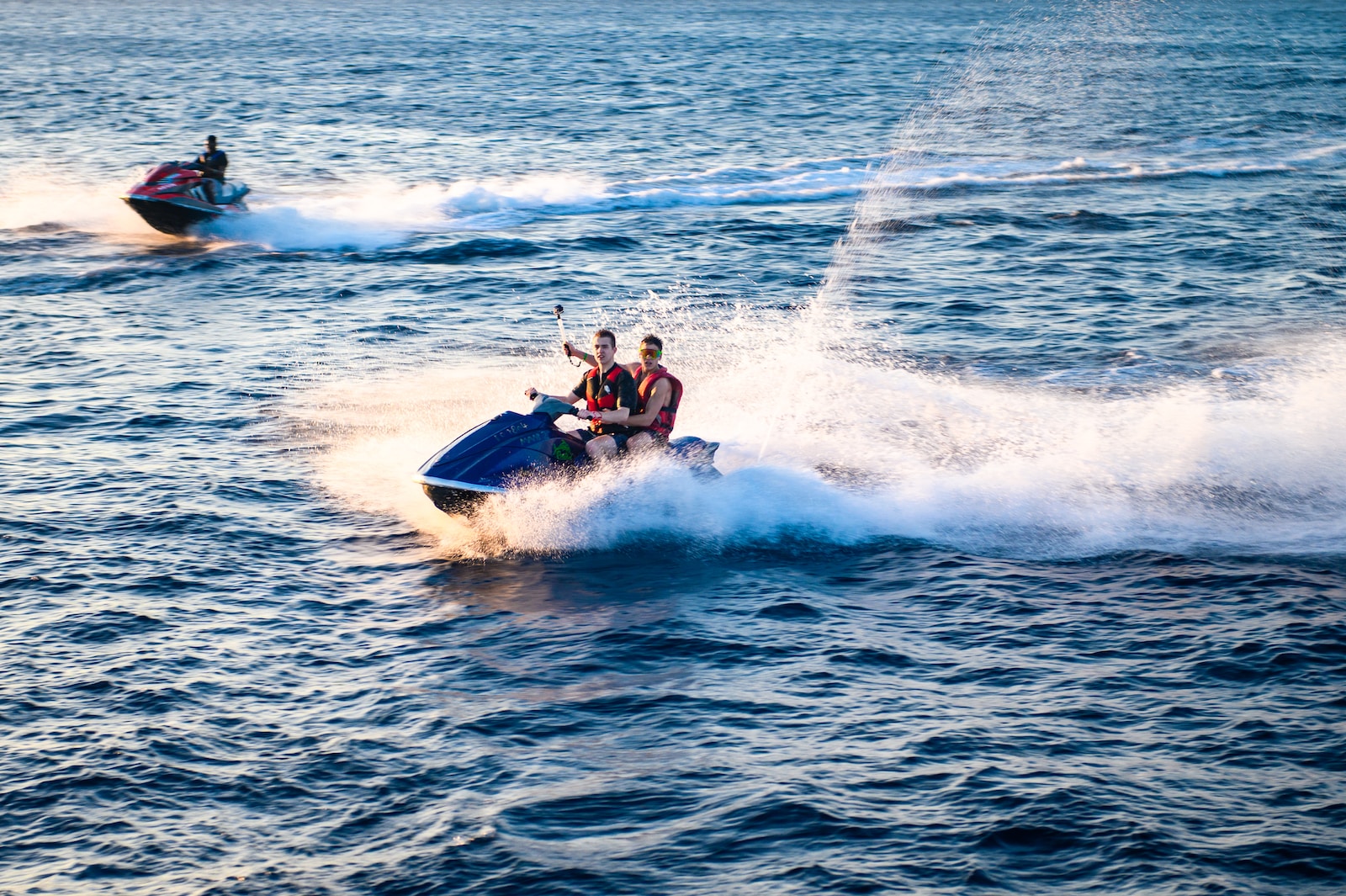Have you ever wondered how a jet ski is able to effortlessly float on water? In this article, we’ll explore the fascinating principle of buoyancy and how it allows jet skis to stay afloat.
You’ll discover the importance of water displacement, how weight distribution plays a role, and the impact of hydrodynamics and design.
Get ready to dive into the world of jet ski stability and learn the secrets behind their ability to glide across the water with freedom and liberation.
Key Takeaways
- Jet skis float on water due to the principle of buoyancy and water displacement.
- Proper weight distribution and body position are essential for maintaining stability and balance on a jet ski.
- The design and hydrodynamics of the jet ski, including the shape and size of the hull, affect its performance, stability, and maneuverability.
- Engine power and propulsion systems, such as the jet pump and throttle control, contribute to the jet ski’s ability to stay afloat and provide an exciting ride.
The Principle of Buoyancy
You might be wondering how jet skis are able to float on water. Well, it all comes down to the principle of buoyancy. This principle states that any object placed in a fluid will experience an upward force equal to the weight of the fluid it displaces.
In simpler terms, the jet ski’s hull is designed in such a way that it displaces a large volume of water, which creates an upward force that counteracts the downward force of the jet ski’s weight. This allows the jet ski to stay afloat on the water’s surface, giving you the freedom to ride and explore.
The hull of the jet ski is typically made from lightweight materials, such as fiberglass or plastic, which helps to reduce its overall weight. Additionally, the hull is shaped in a way that allows it to distribute the weight of the jet ski evenly, helping to maximize buoyancy. This, combined with the powerful engine and propeller, allows the jet ski to glide effortlessly across the water.

Understanding Water Displacement
To understand how jet skis float on water, it’s important to grasp the concept of water displacement. When a jet ski is placed in water, it displaces the water around it, creating an upward force called buoyancy. Here’s how water displacement works:
- Step on a Scale: Imagine standing on a scale. Your weight pushes down on the scale, but the scale pushes back with an equal force, keeping you balanced. Similarly, when a jet ski is on water, its weight pushes down, but the water pushes back, keeping it afloat.
- Pushing Water Aside: When a jet ski is placed in water, it pushes the water aside, creating space for itself. This action causes the water level to rise slightly around the jet ski.
- Upward Force: As the jet ski displaces water, it creates an upward force known as buoyancy. This force is strong enough to counteract the weight of the jet ski, allowing it to stay afloat.
- Enjoy the Freedom: Understanding water displacement and buoyancy gives you the freedom to ride a jet ski and experience the exhilaration of gliding across the water’s surface, feeling the wind in your hair, and enjoying the liberation that comes with it.
The Role of Weight Distribution
When riding a jet ski, it’s important to understand the role of weight distribution in maintaining stability and balance on the water. Proper weight distribution is crucial for maintaining control and stability. When you’re on a jet ski, your body acts as the main source of weight. By shifting your weight forward or backward, you can influence the position of the jet ski in the water. If you lean too far forward, the front of the jet ski will dip, causing it to slow down and potentially lose balance. On the other hand, leaning too far back can cause the jet ski to become unstable and prone to flipping over.
To maintain balance, keep your weight centered and evenly distributed. This means keeping your body upright and aligned with the jet ski. Avoid sudden movements that could throw off the balance, and use your core muscles to stabilize yourself. By actively adjusting your weight distribution, you can ensure a smooth and enjoyable ride on the water.
Hydrodynamics and Jet Ski Design
As you ride a jet ski, it’s fascinating to learn about the hydrodynamics and design principles that allow it to float and maneuver on the water. Here are four key factors that contribute to its ability to glide effortlessly across the waves:
- Hull design: The hull of a jet ski is specifically shaped to create lift and reduce drag. Its sleek and streamlined design allows it to slice through the water with minimal resistance, maximizing speed and maneuverability.
- Jet propulsion system: Unlike traditional boats, jet skis use a jet propulsion system that sucks in water through an intake and forcefully expels it through a nozzle at the back. This powerful jet of water propels the jet ski forward, providing the necessary thrust to overcome the water’s resistance.
- Stability mechanisms: To ensure stability, jet skis are equipped with features such as sponsons and trim tabs. Sponsons are located on the sides of the hull and help improve stability during turns and maneuvers. Trim tabs, on the other hand, can be adjusted to modify the angle of the jet ski’s hull, allowing for better control and balance.
- Buoyancy: Jet skis are designed to be buoyant, meaning they’re capable of displacing enough water to support their weight. This buoyancy is achieved through the use of lightweight materials and careful weight distribution, ensuring that the jet ski remains afloat even with the weight of the rider.
Understanding the hydrodynamics and design principles behind a jet ski’s ability to float and maneuver on the water adds to the thrill and excitement of riding one. So enjoy the freedom and liberation as you glide across the waves on your jet ski!
The Impact of Hull Shape
When riding a jet ski, you’ll notice that the shape of its hull has a significant impact on its performance and stability in the water. The hull shape of a jet ski plays a crucial role in determining how it moves through the water and handles various conditions.
The design of the hull affects its maneuverability, speed, and overall efficiency. A jet ski with a V-shaped hull, for example, cuts through the water more smoothly, reducing drag and allowing for higher speeds. On the other hand, a flat-bottomed hull provides more stability, which is beneficial for beginners or riders who prefer a more comfortable and balanced experience.
The size and curvature of the hull also influence how the jet ski turns and responds to the rider’s movements. A narrower hull allows for sharper turns, while a wider hull provides better stability when riding in rough waters.
Ultimately, the shape of the hull is carefully designed to optimize the jet ski’s performance and ensure an exhilarating and liberating experience on the water.
Engine Power and Propulsion
To fully understand how a jet ski floats on the water, you need to consider the engine power and propulsion it utilizes. The engine of a jet ski generates a powerful force that propels it forward, allowing you to glide across the water with freedom and exhilaration.
Here are four key elements that contribute to the engine power and propulsion of a jet ski:
- Engine Capacity: The larger the engine capacity, the more power it can generate, enabling you to reach higher speeds on the water.
- Jet Pump: The jet pump is responsible for creating the propulsion force. It sucks water into the pump and then expels it out at high pressure, propelling the jet ski forward.
- Impeller: The impeller is a rotating component inside the jet pump that helps to draw in water and then push it out with force. The shape and size of the impeller blades greatly affect the performance of the jet ski.
- Throttle Control: The throttle control allows you to regulate the amount of power being delivered to the engine. By adjusting the throttle, you can increase or decrease the speed and acceleration of the jet ski, giving you complete control over your ride.
With the engine power and propulsion systems working harmoniously, a jet ski can effortlessly float on the water, providing you with the ultimate sense of liberation and adventure.

Factors Affecting Jet Ski Stability
To maintain stability while riding a jet ski, you must be aware of and manage several factors.
The first factor is your body position. Keeping your body centered and balanced on the jet ski will help you maintain control and stability. Lean forward slightly to distribute your weight evenly and improve the grip of the jet ski on the water.
Another important factor is the speed at which you’re riding. Riding at high speeds can make the jet ski more unstable, especially when making sharp turns. It’s essential to adjust your speed according to the water conditions and your skill level. Slow down when necessary to maintain control and stability.
The condition of the water also affects the stability of the jet ski. Rough water, such as choppy waves or strong currents, can make it more challenging to maintain stability. Be cautious and adjust your riding style accordingly.
Lastly, the design and weight distribution of the jet ski itself play a significant role in stability. Jet skis with a wider hull tend to be more stable, while those with narrower hulls may be more maneuverable but less stable. Additionally, proper weight distribution, keeping your weight centered and balanced, helps maintain stability.
Conclusion
So, now you know how a jet ski can float on water.
It all comes down to the principle of buoyancy, which allows objects to float when they displace enough water to counteract their weight.
Factors like weight distribution, hydrodynamics, and engine power also play a role in ensuring jet ski stability.
Overall, understanding these concepts helps us appreciate the design and engineering behind these fun and exciting water vehicles.
